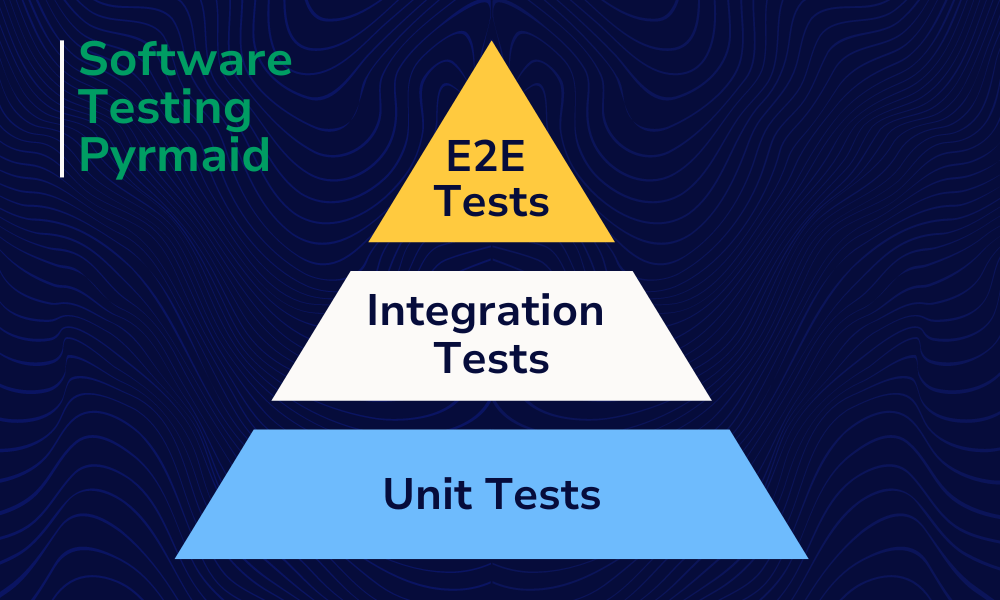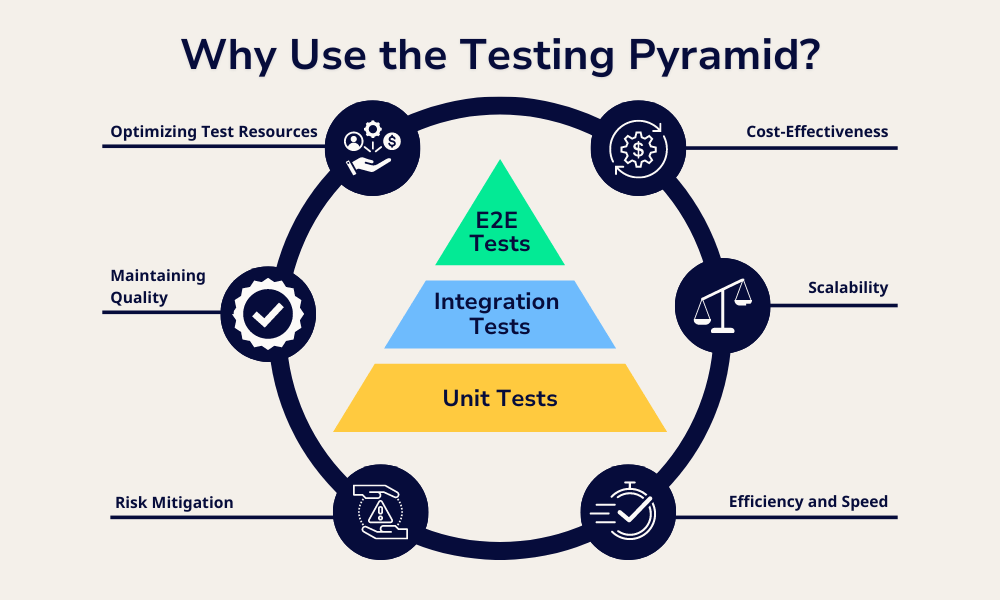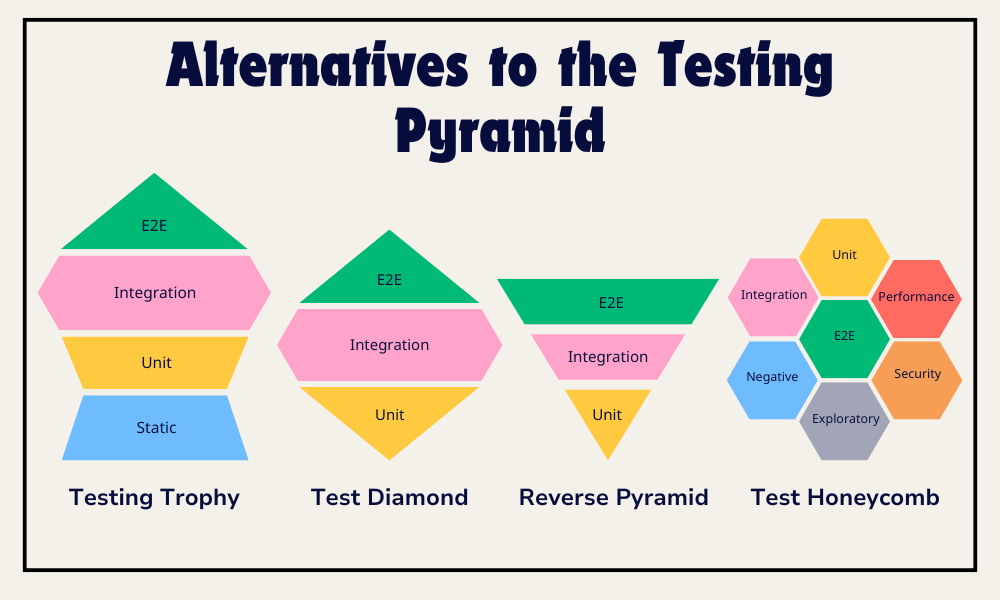Various testing strategies are crucial for ensuring the robustness and reliability of applications. One widely recognized framework is the testing pyramid, a structured approach that helps developers build better features and introduce changes efficiently. Let’s dive into the testing pyramid, its components, and its relevance in modern software development.
What is the Testing Pyramid?

The testing pyramid, also known as the test automation pyramid, is a framework that guides developers in implementing a balanced testing strategy. Mike Cohn introduced the pyramid testing strategy in his book “Succeeding with Agile: Software Development Using Scrum (2009)”. The pyramid visually represents different types of automated tests and their proportions, emphasizing the need for tests of varying granularity and complexity.
Typically, the testing pyramid consists of three primary layers:
- Base (Unit Tests): The largest portion ensures basic functionalities are thoroughly tested.
- Middle (Integration Tests): Moderate portion, validating interactions between components.
- Top (E2E Tests): The smallest portion focuses on critical user journeys and overall system behavior.
These layers reflect the relevance, order of execution, and complexity of tests within the software development lifecycle (SDLC).
Layers of the Testing Pyramid
What are Unit Tests?
Unit tests focus on the smallest components of the codebase, such as functions or methods. They verify that each unit performs as expected under various conditions.
These tests are the pyramid’s foundation, representing the bulk of automated tests due to their simplicity and speed.
Unit tests involve calling a method, passing necessary parameters, making assertions about the results, and evaluating outcomes. They are isolated, ensuring no dependencies affect the results.
What are Integration Tests?
Integration tests are fewer in number in the middle layer but more complex than unit tests. They validate how different system components interact with each other and ensure that combined units function correctly.
Integration tests involve interactions between modules and external systems like APIs. They often require mocking and stubbing to simulate external dependencies.
What are End-to-End (E2E) Tests?
Representing the tip of the pyramid, end-to-end (E2E) tests are the most complex and time-consuming but crucial for ensuring the entire system works as intended. These tests verify the complete functionality and performance of the application by simulating real user scenarios.
E2E tests involve multiple systems, UIs, and external dependencies, requiring advanced tools to emulate user interactions and validate outcomes.
Why Use the Testing Pyramid?
Using a pyramid structure for mobile app testing offers several advantages contributing to efficient, reliable, and comprehensive testing processes. Here are key reasons to adopt the pyramid structure:
- Efficiency and Speed: Unit tests form the pyramid’s base and are quick to write and execute. They focus on individual components or functions, ensuring each part works correctly in isolation.
- Cost-Effectiveness: Unit tests are less expensive to maintain compared to integration and end-to-end tests. Since they test smaller code units, they are simpler to write and do not require complex setups or environments.
- Scalability: A large number of unit tests ensures comprehensive coverage of basic functionality, while integration tests verify the interactions between components, allowing the testing process to scale as the application grows in complexity.
- Risk Mitigation: Although fewer in number due to their complexity and cost, E2E tests are critical for identifying issues that occur in real-world scenarios. This comprehensive approach helps mitigate risks by ensuring that significant workflows function as intended.
- Maintaining Quality: Unit tests ensure that individual pieces of code are robust, integration tests confirm that these pieces work together correctly, and E2E tests validate the user experience. This multi-layered approach enhances the overall quality of the application.
- Optimizing Testing Resources: The pyramid structure ensures optimal use of testing resources by prioritizing unit tests (which are faster and cheaper) over integration and E2E tests (which are slower and more expensive). This allows teams to catch and fix issues early and frequently, reducing the time and cost associated with bug fixes later in the SDLC.
Best Practices for Implementing the Testing Pyramid in Agile Methodology
Implementing the testing pyramid within an Agile framework ensures continuous improvement and responsiveness to change. Here are best practices to integrate the pyramid into Agile methodologies:
- Shift Left Testing: Shift left in the SDLC and begin writing unit tests as soon as development starts.
- Continuous Integration: Integrate automated testing into the continuous integration (CI) pipeline to catch errors early and often.
- Proportionate Testing: Ensure the bulk of your tests are unit tests, followed by integration tests and a smaller number of E2E tests. This balance helps in quick issue identification with minimal maintenance overhead.
- Code and Test Reviews: Regularly review and refactor your code and tests to maintain quality and relevance. Peer reviews help identify gaps and potential improvements.
- Test-Driven Development (TDD): Adopt Test-Driven Development (TDD) practices to ensure tests are written before the code. This helps create a robust suite of unit tests and ensures that the code meets the test criteria from the outset.
- Continuous Feedback: Use Agile retrospectives to gather feedback on the testing process and make iterative improvements.
Criticisms and Alternatives to the Testing Pyramid
While the testing pyramid is widely accepted, it has faced criticisms:
- Value Consideration: Some argue that complex tests catching all errors might reduce the need for numerous unit tests.
- Resource Assumptions: Implementing a comprehensive testing strategy requires significant resources and expertise.
- Modern Relevance: With advancements in automation, some believe the pyramid needs updates to reflect current testing practices.
- Manual Tests: The pyramid primarily focuses on automation, overlooking the necessity of manual testing in certain scenarios.
Alternatives to the Testing Pyramid
- Testing Trophy: Introduced by Kent Dodds, this model emphasizes static and integration tests more than unit tests, adapting to modern testing needs.
- Reverse Pyramid: Flipping the pyramid, this model suggests focusing more on E2E tests to simulate user experiences better.
- Test Diamond: An evolution of the traditional test pyramid, advocating for more integration and service tests compared to the test pyramid, while still maintaining a strong base of unit tests and a smaller number of end-to-end tests at the top.
- Test Honeycomb: A modern testing framework that promotes extensive and diverse testing methodologies, emphasizing the importance of exploratory testing, performance testing, and security testing in addition to the traditional layers of unit, integration, and end-to-end tests.
Conclusion: Using the Testing Pyramid for Effective Software Development
The testing pyramid remains a valuable framework for structuring test suites effectively. Despite criticisms and emerging alternatives, its core principles of balancing different types of tests ensure robust and reliable software development. By understanding and applying the testing pyramid, developers can create efficient testing strategies that enhance the quality and performance of their applications.
Take Your Testing to the Next Level with Sofy
Ready to implement the testing pyramid in your mobile app development? Sofy offers a powerful platform to automate your testing processes seamlessly. With Sofy, you can efficiently create, manage, and execute unit, integration, and end-to-end tests, ensuring comprehensive coverage and high-quality results.
Experience the benefits of a robust testing strategy with Sofy. Request a demo today!











